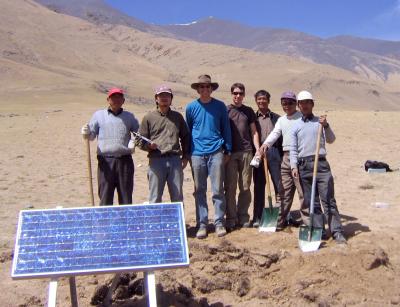NMSU scientists unlock secrets of continent building, climate change using research on the Tibetan Plateau

NMSU physics professor James Ni, who has spent more than 30 years studying the collision of continents and the deformation of the Tibetan Plateau, said it was speculated that the harder part of Asia, in the middle of China, has relatively rigid lithosphere pushing down beneath northern Tibet, but research through INDEPTH has confirmed that's not what is happening.
In reality, "India is subducted beneath Asia," said James Ni, one of NMSU's principal investigators for the project. "As a result of this collision, southern Tibet is underlain by the Indian continent and everything soft,will be deforming internally. The crust and mantle lithosphere of eastern Tibet are being broken up by major strike-slip faulting. The more rigid part of the crust is brittle and the lower part is behaving like a viscous medium, so we want to see how this deformation is vertically coherent or if the bottom part is behaving differently from the upper crust."
Although numerous Chinese and international studies of the plateau were conducted in the 70s and 80s, INDEPTH - started in 1992 - was the first to use deep seismic reflection profiling to explore the continental lithosphere beneath the Himalayas and Tibet. The NMSU part of INDEPTH-4 was supported by a $755,000 grant from the National Science Foundation, and the INDEPTH project has been the longest-running project supported by NSF to date.
Two factors have played a part in the deformation of the northern and eastern plateau according to Ni. Gravitational potential energy is released due to the approximately 17,000 feet high elevation of the plateau, and the northeast and southeast margins of the plateau have open boundaries.
"You can imagine if you have some kind of soft clay materials and if you're holding it up and you let your hand go on one side, the stuff will collapse," Ni said. "So it's consistent with topography, consistent with the geometry of Quaternary faults and the measurements from the GPS and seismic data."
Ni and NMSU physics professor Thomas Hearn began work with INDEPTH during the second phase in the 1994; International collaborators from Germany, China, Canada, Ireland, United Kingdom and the United States are involved in the four-phase interdisciplinary program to develop a better understanding of the deep structure and mechanics of the Himalaya-Tibet collision zone.
A major part of Phase IV of the project, also known as Project ASCENT (Array Seismology Collaborative Experiments of Northern Tibet), began in 2007 and focused on collecting mainly passive-source seismic data from the northeastern part of the plateau. NMSU partnered with the University of Missouri, Cambridge University and Peking University in the broadband experiment during this final stage of the project.
Ni and Hearn, with collaborators and their students, installed about 100 temporary, solar-powered seismic stations in the northeastern Tibet to collect passive earthquake source recordings. Hearn spent three consecutive summers on the plateau for field deployments.
"The stations stay in place for about two years with us returning to service and download data every half year," Hearn said. "These sites are at elevations of around 14,000 feet in the high plateau. Grass is all that grows; the Tibetans graze sheep and yak on it. It's desolate but spectacular because of it."
In September 2010, the final seismic station was removed and researchers across two continents began to analyze the data. The scientists are currently looking at earthquake-generated seismic waves, both body waves and surface waves.
"From the different waves, we can get velocity information of the crust and upper mantle and the attenuation structure," Ni said. "That tells us about how the material is made and its physical properties."
Studying the data, Ni was surprised to find that the low velocity zone in northern Tibet was smaller than the scientists had found previously.
"We expected that laterally the low velocity zone would be over 400-500 kilometers in a north and south direction, but it turned out in some places it was only 200 or 300 kilometers," Ni said. "It turned out that in parts of northeastern Tibet, between latitude 92E to 100E, a former collision about 150 Ma ago left either an oceanic slab or a small piece of continent beneath that part of the plateau."
Researchers still don't know how much of the Indian plate was subducted underneath Tibet, but they are understanding more about the height of Tibet and how it may tie into climate change. Apparently, the uplift of the Plateau at about 8 million years ago is related to the initiation of monsoons in Pakistan, India and Bangladesh.
"Knowing the uplift history will help scientists to model the global climactic pattern better, or at least understand how the climate evolves and how the monsoons develop in India," Ni said. "So knowledge gained from studying Tibet will affect people in that part of the world greatly."
The seismic data are currently held at the IRIS data center, and are available to anyone who wishes to analyze them. Ni said three papers on the topic were published last year, and this year two papers have been accepted by the Journal of Geophysical Research, with two more under review.
"For now, our work in Tibet is temporarily over, and we'll be waiting for the next opportunity and younger generations to accomplish the next chapter on trying to understand Tibet," Ni said.
For more information about the international project visit http://www.geo.cornell.edu/geology/indepth/indepth.html.


